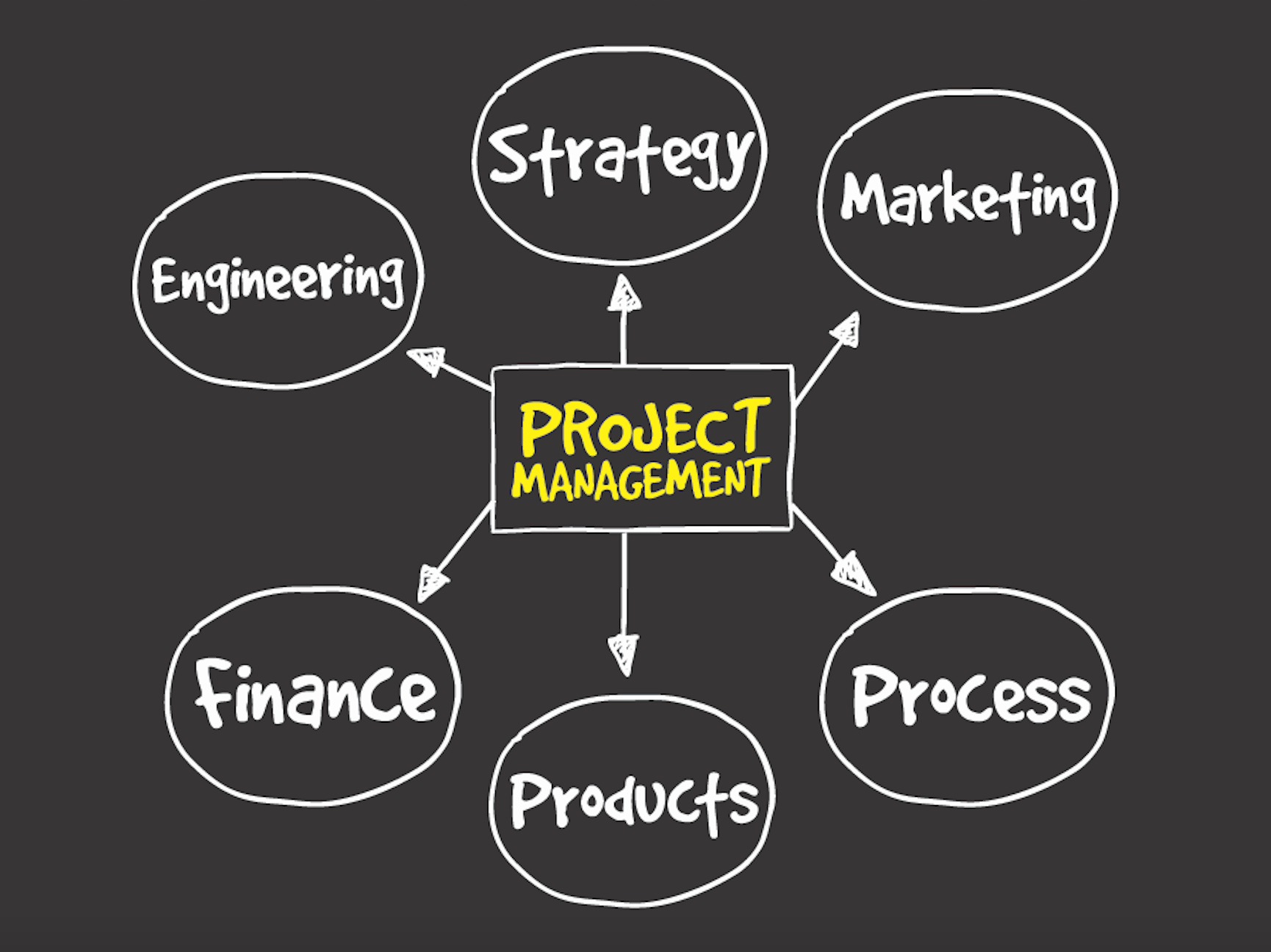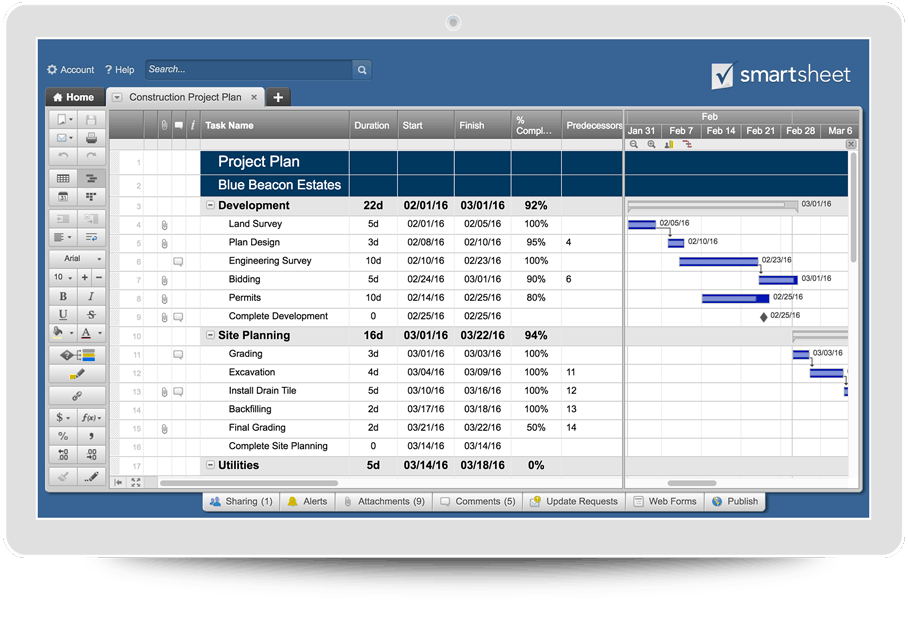What is Schedule Variance?
In earned value management, schedule variance helps you figure out if you are ahead of or behind schedule, and by how much. PMs use the schedule variance formula when they are figuring out their remaining resources, so they can best utilize them. Specifically, Schedule Variance (SV) is the difference between the cost of work performed and the cost of work scheduled; the Earned Value (EV) minus the Planned Value (PV).
SV = schedule variance, EV = earned value, PV = planned value
OR
SV = schedule variance, BCWP = budgeted cost of work planned, BCWS = budgeted cost of work scheduled
Both formulas are identical in meaning. The only difference is the analyst’s preference for the verbiage. If you calculate SV and the value is positive, you are ahead of schedule. If you calculate SV and the value is negative, you are behind schedule. If you calculate schedule variance and the value is zero, you are on schedule. Schedule variance is zero at the completion of a project because all of the planned value has been earned.
Planned value (PV) is the scheduled cost of work that will be performed in a specific timeframe. It is the value of the money spent, based upon the schedule. PV is also known as the Budgeted Cost of Work Scheduled (BCWS).
Earned value (EV) is the amount of money earned from the completed work in a specific timeframe. It is the value of the work completed to date. EV is also known as the Budgeted Cost of Work Performed (BCWP).
BAC is the Budget at Completion. BAC is determined at the start of a project, and may be revised as the project progresses based upon its forecast. BAC is the total spending, both anticipated and budgeted. It is constructed from the estimates and assumptions of the project. BAC should be established early in the contract for every level of the work breakdown structure. BAC is sometimes known as the “approved budget.”
Actual Cost (AC) is what you have spent on a project. There are no specific formulas to determine AC, as it is a summation of what has been spent.
Project Management Guide
Your one-stop shop for everything project management

Ready to get more out of your project management efforts? Visit our comprehensive project management guide for tips, best practices, and free resources to manage your work more effectively.
Earned Value Management in Project Cost Management
The PMI, explained through the Project Management Body of Knowledge (PMBOK), requires potential certified professionals to be able to answer the status of their projects. Project Cost Management’s (PCM) main function is to complete a project on time within the approved budget. PCM is one of the ten knowledge areas outlined in the Project Management Body of Knowledge. The processes of PCM include planning cost management, estimating costs, determining budgets, and controlling costs. A PM uses Project Cost Management Plans to accomplish this work. Templates are available in order to describe how costs will be planned, structured, and controlled. Most experts consider the cost management portion of project management to be the weakest area. This is why it is critical for PMs to make use of available resources and plan the cost section carefully.
In PCM, Earned Value Management (EVM) is a clear indication of how a project is doing. EVM has been a required measure for federal U.S. government projects since 2005. EVM details the actual and forecasted accomplishments of the project and allows PMs to identify problems in the early stages and to manage them proactively. They detail scope, cost, and the schedule. EVM analyses also include cost performance, schedule performance, cost variance, and schedule variance.
5 Useful Tips for Studying for the PMP
Preparing for the PMP exam can be an overwhelming task. There are countless websites, guides, and blogs on how other professionals in the past have studied, passed, or learned from their failures. The main recommendation from everyone is to ensure that you have enough time. Take the time to study, learn the concepts, and figure out a way to remember them. It seems like a simple approach. This section gives you some study hacks that engage your brain better than straight memorization work. Using these ideas, you can ensure that your lessons stick, and are available when you need them.
1. Use Mnemonic Devices: According to a professor from the University of Central Florida, there are nine types of mnemonic devices for memorization work. Whether you choose mnemonics that are based in music, rhymes, expressions, or names of your loved ones, they can help you remember even the most banal of details. Here are some famous examples that we may not even consider memory devices.
“Spring forward, fall back:” Without this mnemonic device, would we remember which way our clocks are set twice annually?
Kids that have had to learn their scales for the treble clef remember this simple chant, listing them in their respective order (EGBDF). With so many formulas to memorize for the PMP exam, using mnemonic devices to get them straight in your head will allow you to focus more on the actual calculations and how they are applied to the questions.
2. Mind-mapping: Mind maps are drawn as visual diagrams that help organize concepts. They can show hierarchy or just a way to organize your inputs. Usually, mindmaps radiate out from a central concept and show branching as different hierarchies and concepts are drawn in. There are no hard and fast rules for mind maps, other than that they should represent your information in an organized spatial way. In a study by Paul Ferrand, mind maps can improve studying retention by at least 15 percent.
A mind map of projected costs.
3. Teach Someone Else: According to the NDT Resource Center of Iowa State University, almost 90% of material is retained when you are able to teach it to someone else. When you teach the concepts that you are learning, it forces your brain to rearrange the concepts so that they can be verbalized. Additionally, teaching allows you to re-conceptualize the material in a way that disparate people can understand. Other people can ask questions, which forces you to fill in the holes of your knowledge. If peer-study groups where you teach each other are not feasible, practice teaching the concepts to whomever is around, be it your dog, child, or vacuum cleaner. The point is just to arrange the concepts in your head well enough that you can verbalize them.
He’s listening.
4. Relate the Material to Your Own Life and Work: Whether you currently work in the medical field or in construction, the concepts on the PMP exam can be associated with something in your work or home life. Even if you are only considering home projects, such as repainting your bathroom, you can use the PMP concepts to solidfy the concepts in your mind. A simple coat of blue paint can have a budget assigned and a work breakdown structure for which your resources (your children?) can complete milestones.
5. Find Your Motivation: Studies show that motivation affects how well someone performs on a test. At first blush, this seems like an obvious concept. Of course, people who are more motivated study harder, and perform better on tests. However, having a clear answer to the question, “Why am I taking the PMP?” can frame your whole study process and test event. According to a study out of Queen’s University in Canada, test-takers who took “high-stakes” tests performed significantly better than those who were not as motivated. So, it is worthwhile to ask yourself the hard questions about why you are preparing for the PMP, and whether it is a worth all of the hardship and effort.
The PMP Exam and How to Calculate Schedule Variance
The PMP exam is a 200-question, multiple-choice test. Each question has only one correct answer. Examinees have four hours to complete these questions. The score to pass is not published by the PMI, but some experts suggest that it is between 61% and 75%.
In order to be eligible to sit for the exam, candidates should have attended at least 35 hours of classroom training in the subject of project management. Additionally, candidates must have between 4,500 and 7,500 hours of project management experience in the five process groups (Initiating, Planning, Executing, Monitoring & Controlling, and Closing), depending on their earned education level.
There are six types of questions on the PMP exam. These are formula-based, situational, knowledge-based, interpretational, specific technique, and PMBOK Guide knowledge questions. The main types of formula questions cover Earned Value, PERT, communication, procurement, probability, network diagrams, project selection, depreciation, and mathematical basics. You should know about 49 formulas for the PMP exam.
Schedule Variance Example Formulas Calculated
The following section has example problems that are representative of problems found on the PMP for schedule variance.
Scenario:
Ava is a project manager who has a housing project that needs to be completed in nine months. The cost of her project is $200,000. After three months, 25% of the work has been completed (as per the schedule, 30% should be completed), and $45,000 has been spent. What is her project’s planned value (PV), earned value (EV), schedule variance (SV), and is Ava’s project ahead or behind schedule?
Given:
Project duration = 9 months
Time elapsed = 3 months
Project Cost (BAC) = $200,000
Actual Cost = $45,000
Percent (should be) complete = 30%
Percent (actually) complete = 25%
Closely Related Formulas to Schedule Variance
Cost Variance (CV)
Additionally, Ava could calculate the Cost Variance (CV) of her project, since the bottom line is exceedingly important to proper project completion. Stakeholders may be willing to give more time to a properly performed project, but it may be difficult to convince them to give more money. Similar to schedule variance, if CV is positive, it means you are under budget. If CV is negative, it means that you are over budget. If CV is zero, you are on budget.
The formula for CV = Earned Value – Actual Cost. From the above example, we can calculate the Cost Variance for Ava’s housing project. We can also calculate whether she is over budget or under budget.
Schedule Variance Percentage (SV%)
Schedule variance percentage (SV%) is a key performance indicator (KPI) that shows how closely a PM is sticking to the schedule in terms of percentage. A KPI is a performance metric that organizations use to determine how closely their company or employees are to achieving their company’s strategic or operational goals. KPIs are used to compare performances of companies or individuals. SV% shows that the work is behind schedule when it has a negative value. An SV% with a positive value shows that work is ahead of schedule. An SV% of zero value shows work is on schedule. SV% is calculated by the following formula:
SV% = SV/PV
For Ava’s housing project above, the SV% can be calculated.
Ava will need to have 17% of work done to be on track with her schedule in terms of budgeted cost.
Calculate Schedule Variance Using Excel-type Programs
PMs often need to calculate their SV quickly and efficiently. Using excel-type programs allows an electronic calculation to be performed. The SV formula can also be set up so that it is performed automatically. Excel uses the statistical function VAR to calculate schedule variance, if it is setup correctly. PMs must set up their data in excel in columns. Smartsheet has a comprehensive tutorial on setting up and calculating baseline schedule variance, in addition to templates and a comprehensive software suite for PMs.
To Complete Schedule Performance Indicator (TSPI) Calculation
To Complete Schedule Performance Indicator (TSPI) is a KPI that is a project efficiency rating. It shows how the remaining project time should be used by giving you the percentage of efficiency that your resources should work on in order to keep the project on track. If the TSPI is less than 1, than the assigned resources need to work harder to complete the project. If the TSPI is more than 1, then the assigned resources can work at the project less. It the TSPI is exactly 1, than the assigned resources are exactly on track to complete the project. The formula for TSPI = (Total Project Cost – Earned Value) / (Total Project Cost – Planned Value). From the above example, we can calculate Ava’s project TSPI. We can also determine whether her assigned resources need to work harder on her project or whether they can work additional projects.
Schedule Variance Calculation Tips and Warnings
It is fine to be able to perform the schedule and cost variance formulas, and provide metrics to the stakeholders of your projects. Planning and following a project is one thing, but managing it effectively has its own unique challenges. The following are tips and warnings that the formulas above do not take into account.
- To complete the formal portion of the project planning process, calculate a baseline schedule variance. This is critical to be able to assess how your project is going.
- Look for scheduling conflicts: for example, if a milestone shown on your Gantt chart is earlier than their predecessor, they have an inflexible constraint. Review the schedule to ensure that this constraint is necessary.
- When schedule variances are identified, remember that there may also be cost variances associated with them. Schedule variances can be used as early warning signs that the project schedule may need to slip. It is time to review what the associated costs (such as rental equipment or employee time spent) may be contingent upon within the agreed-upon schedule.
- Check your variance calculations twice.
- Monitor the quality of your projects, not just the schedule and cost variances. Just because a project is ahead of schedule or on budget does not mean that quality setbacks are not a real threat.
Some Problems with Estimates
Remember that your variance estimates are indeed just estimates. There may be problems with the calculations that are unforeseen.
Calculation: Estimates are performed too quickly, performed by novices, or show bias.
False Analogies: Using historical data from past projects is a good way to come up with estimates. However, an experienced PM knows what is and isn’t relevant. It is critical that data is applicable in the right way. Be aware of projects that seem similar, but are only so on the surface.
Subjectivity: The calculations on variance and estimation are provided so that there is a mathematical basis for a PM’s actions. As a PM, you should be able to justify your actions and decisions to your stakeholders. Estimates that are pulled from the ether or are of a subjective nature run the risk of going over schedule or over budget.
Schedule Variance Formula List
According to the PMI, there are 47 formulas (processes), 10 knowledge areas, 19 numerical values, and 26 acronyms that must be learned (memorized and understood) in order to take the PMP certification exam. Professionals who have taken the exam say that there are about five questions on Earned Value Management (EVM) concepts (those presented here). EVM has three different types of values and measurements. These include Project Plan, Project Status, and Project Forecast.
Project Plan Concepts
Budget at Completion (BAC)
Planned Value (PV)
Project Status Concepts
Schedule Variance
Cost Variance
Schedule Performance Index (SPI)
Cost Performance Index (CPI)
Project Forecast
Estimate to Complete (ETC)
Estimate at Completion (EAC)
Variance at Completion (VAC)
To Complete Performance Index Original Budget (TCPI)
To Complete Performance Index Revised Budget (TCPI)
Support for PMP Examinees
If you are preparing to take the PMP exam, there are countless websites devoted to getting your knowledge up to par to pass the exam. The vast majority of these cost money. The PMI sponsors local courses and support groups with a membership. There are also countless Reddit boards, Quora topics, Slack groups, and social media sites where advice, support, and some materials may be found free of charge. Experts recommend not sticking to one study guide specifically, but buying multiple study guides from different organizations because the materials are so disparate, and some guides may be more suited to your learning style than others. The last recommendation from experts is that prospective PMP candidates take practice tests - as many as they can, and to score at least 80% on each of them before they attempt the PMP exam itself.
See How Easy it Can Be to Run Schedule Variance with Smartsheet
From simple task management and project planning to complex resource and portfolio management, Smartsheet helps you improve collaboration and increase work velocity -- empowering you to get more done.
The Smartsheet platform makes it easy to plan, capture, manage, and report on work from anywhere, helping your team be more effective and get more done. Report on key metrics and get real-time visibility into work as it happens with roll-up reports, dashboards, and automated workflows built to keep your team connected and informed.
When teams have clarity into the work getting done, there’s no telling how much more they can accomplish in the same amount of time. Try Smartsheet for free, today.





